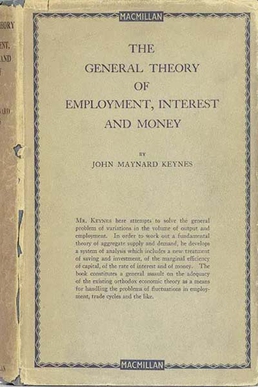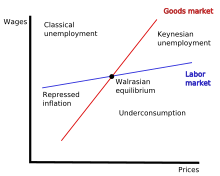Economics is a social science that studies the production, distribution, and consumption of goods and services.
Keynesian economics are the various macroeconomic theories and models of how aggregate demand strongly influences economic output and inflation. In the Keynesian view, aggregate demand does not necessarily equal the productive capacity of the economy. It is influenced by a host of factors that sometimes behave erratically and impact production, employment, and inflation.

Labour economics, or labor economics, seeks to understand the functioning and dynamics of the markets for wage labour. Labour is a commodity that is supplied by labourers, usually in exchange for a wage paid by demanding firms. Because these labourers exist as parts of a social, institutional, or political system, labour economics must also account for social, cultural and political variables.

Macroeconomics is a branch of economics that deals with the performance, structure, behavior, and decision-making of an economy as a whole. This includes regional, national, and global economies. Macroeconomists study topics such as output/GDP and national income, unemployment, price indices and inflation, consumption, saving, investment, energy, international trade, and international finance.
Full employment is a situation in which there is no cyclical or deficient-demand unemployment. Full employment does not entail the disappearance of all unemployment, as other kinds of unemployment, namely structural and frictional, may remain. For instance, workers who are "between jobs" for short periods of time as they search for better employment are not counted against full employment, as such unemployment is frictional rather than cyclical. An economy with full employment might also have unemployment or underemployment where part-time workers cannot find jobs appropriate to their skill level, as such unemployment is considered structural rather than cyclical. Full employment marks the point past which expansionary fiscal and/or monetary policy cannot reduce unemployment any further without causing inflation.

Joseph Eugene Stiglitz is an American New Keynesian economist, a public policy analyst, and a full professor at Columbia University. He is a recipient of the Nobel Memorial Prize in Economic Sciences (2001) and the John Bates Clark Medal (1979). He is a former senior vice president and chief economist of the World Bank. He is also a former member and chairman of the Council of Economic Advisers. He is known for his support for the Georgist public finance theory and for his critical view of the management of globalization, of laissez-faire economists, and of international institutions such as the International Monetary Fund and the World Bank.
New Keynesian economics is a school of macroeconomics that strives to provide microeconomic foundations for Keynesian economics. It developed partly as a response to criticisms of Keynesian macroeconomics by adherents of new classical macroeconomics.
The Phillips curve is an economic model, named after Bill Phillips, that correlates reduced unemployment with increasing wages in an economy. While Phillips did not directly link employment and inflation, this was a trivial deduction from his statistical findings. Paul Samuelson and Robert Solow made the connection explicit and subsequently Milton Friedman and Edmund Phelps put the theoretical structure in place.

The General Theory of Employment, Interest and Money is a book by English economist John Maynard Keynes published in February 1936. It caused a profound shift in economic thought, giving macroeconomics a central place in economic theory and contributing much of its terminology – the "Keynesian Revolution". It had equally powerful consequences in economic policy, being interpreted as providing theoretical support for government spending in general, and for budgetary deficits, monetary intervention and counter-cyclical policies in particular. It is pervaded with an air of mistrust for the rationality of free-market decision making.
The term efficiency wages was introduced by Alfred Marshall to denote the wage per efficiency unit of labor. Marshallian efficiency wages are those calculated with efficiency or ability exerted being the unit of measure rather than time. That is, the more efficient worker will be paid more than a less efficient worker for the same amount of hours worked.
In economics, money illusion, or price illusion, is a cognitive bias where money is thought of in nominal, rather than real terms. In other words, the face value of money is mistaken for its purchasing power at a previous point in time. Viewing purchasing power as measured by the nominal value is false, as modern fiat currencies have no intrinsic value and their real value depends purely on the price level. The term was coined by Irving Fisher in Stabilizing the Dollar. It was popularized by John Maynard Keynes in the early twentieth century, and Irving Fisher wrote an important book on the subject, The Money Illusion, in 1928.
Constantine Christos "Costas" Azariadis is a macroeconomist born in Athens, Greece. He has worked on numerous topics, such as labor markets, business cycles, and economic growth and development. Azariadis originated and developed implicit contract theory.
The neoclassical synthesis (NCS), neoclassical–Keynesian synthesis, or just neo-Keynesianism was a neoclassical economics academic movement and paradigm in economics that worked towards reconciling the macroeconomic thought of John Maynard Keynes in his book The General Theory of Employment, Interest and Money (1936). It was formulated most notably by John Hicks (1937), Franco Modigliani (1944), and Paul Samuelson (1948), who dominated economics in the post-war period and formed the mainstream of macroeconomic thought in the 1950s, 60s, and 70s.
New classical macroeconomics, sometimes simply called new classical economics, is a school of thought in macroeconomics that builds its analysis entirely on a neoclassical framework. Specifically, it emphasizes the importance of rigorous foundations based on microeconomics, especially rational expectations.

Macroeconomic theory has its origins in the study of business cycles and monetary theory. In general, early theorists believed monetary factors could not affect real factors such as real output. John Maynard Keynes attacked some of these "classical" theories and produced a general theory that described the whole economy in terms of aggregates rather than individual, microeconomic parts. Attempting to explain unemployment and recessions, he noticed the tendency for people and businesses to hoard cash and avoid investment during a recession. He argued that this invalidated the assumptions of classical economists who thought that markets always clear, leaving no surplus of goods and no willing labor left idle.
In macroeconomics, rigidities are real prices and wages that fail to adjust to the level indicated by equilibrium or if something holds one price or wage fixed to a relative value of another. Real rigidities can be distinguished from nominal rigidities, rigidities that do not adjust because prices can be sticky and fail to change value even as the underlying factors that determine prices fluctuate. Real rigidities, along with nominal, are a key part of new Keynesian economics. Economic models with real rigidities lead to nominal shocks having a large impact on the economy.
In economics, implicit contracts refer to voluntary and self-enforcing long term agreements made between two parties regarding the future exchange of goods or services. Implicit contracts theory was first developed to explain why there are quantity adjustments (layoffs) instead of price adjustments in the labor market during recessions.
Disequilibrium macroeconomics is a tradition of research centered on the role of disequilibrium in economics. This approach is also known as non-Walrasian theory, equilibrium with rationing, the non-market clearing approach, and non-tâtonnement theory. Early work in the area was done by Don Patinkin, Robert W. Clower, and Axel Leijonhufvud. Their work was formalized into general disequilibrium models, which were very influential in the 1970s. American economists had mostly abandoned these models by the late 1970s, but French economists continued work in the tradition and developed fixprice models.
In labour economics, Shapiro–Stiglitz theory of efficiency wages is an economic theory of wages and unemployment in labour market equilibrium. It provides a technical description of why wages are unlikely to fall and how involuntary unemployment appears. This theory was first developed by Carl Shapiro and Joseph Stiglitz.
Keynes's theory of wages and prices is contained in the three chapters 19-21 comprising Book V of The General Theory of Employment, Interest and Money. Keynes, contrary to the mainstream economists of his time, argued that capitalist economies were not inherently self-correcting. Wages and prices were "sticky", in that they were not flexible enough to respond efficiently to market demand. An economic depression for instance, would not necessarily set off a chain of events leading back to full employment and higher wages. Keynes believed that government action was necessary for the economy to recover.






